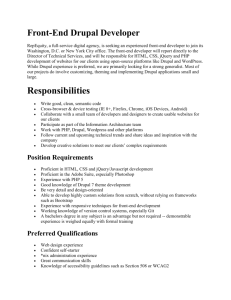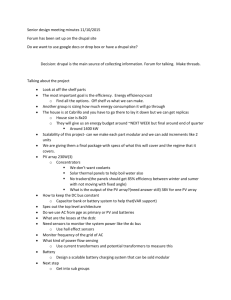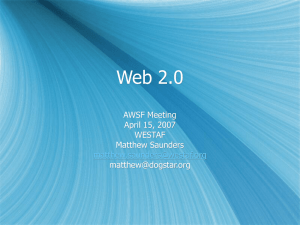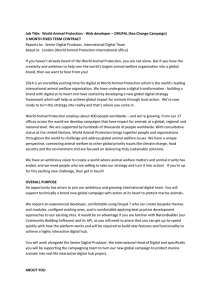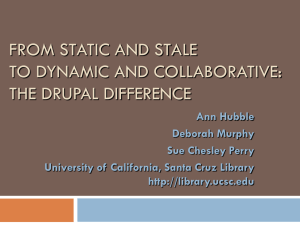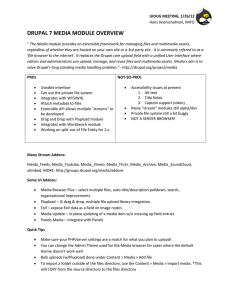Drupal Online Tutorial
advertisement
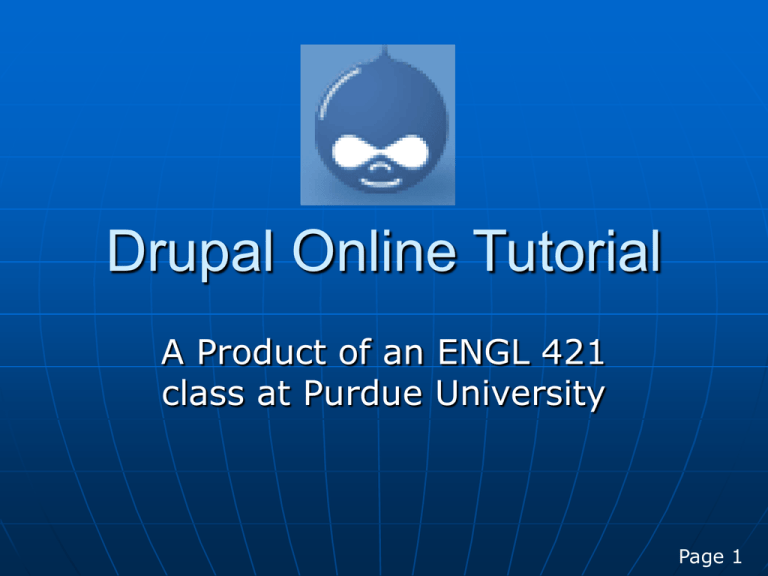
Drupal Online Tutorial A Product of an ENGL 421 class at Purdue University Page 1 What is Drupal? Drupal is an open-source platform and content management system for building dynamic web sites offering a broad range of features and services including user administration, publishing workflow, discussion capabilities, news aggregation, metadata functionalities using controlled vocabularies and XML publishing for content sharing purposes. Page 2 What is Drupal? What is Open-Source? • Open Source means that whoever writes a piece of computer code makes it available for anybody else to see it, modify it, or use it. • GPL (GNU [GNU Not Unix] Public License) is the most common opensource license standard. Page 2 What is Drupal? What is Content Management? • Web pages are often easily created with static (non-changing) content, but it is usually very difficult to make regular changes to a page. Content Management is the process of easily changing what a user sees at a web page. Page 2 What is needed to run Drupal? A web server capable of executing PHP scripts • recommended: Apache PHP • Recommend using the latest stable release A PHP supported database server • recommended: mySQL Page 3 Bugs, Bugs, Bugs If you find a bug in Drupals’ open source software the solution to your problem can be solved by using the Bug Tracker system. The Bug Tracker was set up so that if a bug is found in the code it can be reported on the Drupal website. The reports that are submitted are a huge factor in making Drupal a reliable software. It will also save you a lot of time. Page 4 I found a Bug, How can I report it? First of all if you have found a bug in the software make sure that the you are using the newest version of Drupal (currently 4.2.0). Some of the bugs found may be corrected when you change versions, If you do find a bug and are running the newest version then bugs can be reported to Drupal.org Bug Tracker Page 4 Submit New Bug To report a bug just scroll down to the bottom of Drupal’s page and click on the button labeled “Submit new bug.” From there you will need to fill out a few fields of information such as the title and version of Drupal that you are currently using as well as a description of the bug. You do not have to be a member of Drupal.org or even logged in to submit bug information. Page 4 How else can I report Bugs There is another way to report bugs. • If you are a member of Drupal.org you can also send in bug reports by using a development list at Drupaldevel@drupal.org. Page 4 How do I Develop and Use a Module? Modules are used to add menus to Drupal Examples of available modules are: stories, blogs, polls, images, etc Creating modules in Drupal is simple: • It is simply a text file, including PHP code, in the directory that ends in .module • Allows the use of any text editor Page 5 How to Use a Node Module. Nodes are the individual pieces of content which make up the entire Drupal community—like individual page in website Node Modules differ from regular modules in that they contain a _node hook. What is a _node hook?: • A Special PHP function that is defined in a module What the _node hook does for the module: • Tells Drupal what type node the module defines. Page 5 How do I change a theme The desired theme must be downloaded to the server • Existing documentation explaining this step in detail Administration > Site Configuration > Themes • Select desired theme in default theme dropdown box Sets the default theme seen by most users, although users can change the theme to what they want by editing their accounts Page 6 How Do I Add a Poll? The Poll module must be installed • Instructions Here. To create a poll a user needs the "create polls" permission. To vote on a poll question a user must have the "vote on polls" permission. To view the results one needs the "access content" permission. To administer polls you need the "administer nodes" permission. Page 7
